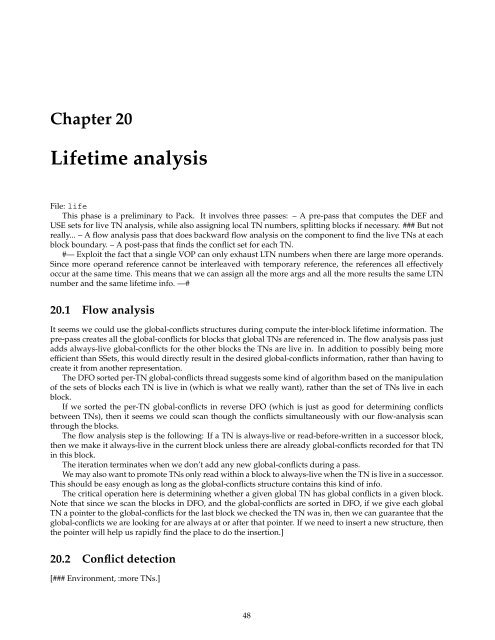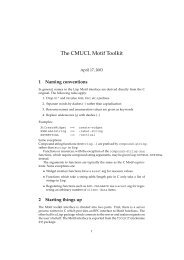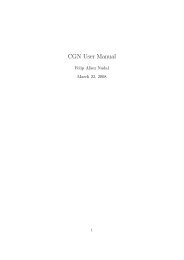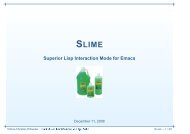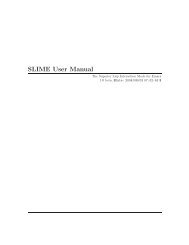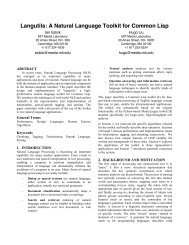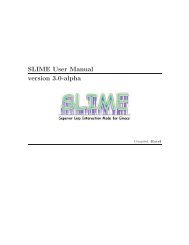Design of CMU Common Lisp.pdf - Common Lisp.net
Design of CMU Common Lisp.pdf - Common Lisp.net
Design of CMU Common Lisp.pdf - Common Lisp.net
Create successful ePaper yourself
Turn your PDF publications into a flip-book with our unique Google optimized e-Paper software.
Chapter 20<br />
Lifetime analysis<br />
File: life<br />
This phase is a preliminary to Pack. It involves three passes: – A pre-pass that computes the DEF and<br />
USE sets for live TN analysis, while also assigning local TN numbers, splitting blocks if necessary. ### But not<br />
really... – A flow analysis pass that does backward flow analysis on the component to find the live TNs at each<br />
block boundary. – A post-pass that finds the conflict set for each TN.<br />
#— Exploit the fact that a single VOP can only exhaust LTN numbers when there are large more operands.<br />
Since more operand reference cannot be interleaved with temporary reference, the references all effectively<br />
occur at the same time. This means that we can assign all the more args and all the more results the same LTN<br />
number and the same lifetime info. —#<br />
20.1 Flow analysis<br />
It seems we could use the global-conflicts structures during compute the inter-block lifetime information. The<br />
pre-pass creates all the global-conflicts for blocks that global TNs are referenced in. The flow analysis pass just<br />
adds always-live global-conflicts for the other blocks the TNs are live in. In addition to possibly being more<br />
efficient than SSets, this would directly result in the desired global-conflicts information, rather than having to<br />
create it from another representation.<br />
The DFO sorted per-TN global-conflicts thread suggests some kind <strong>of</strong> algorithm based on the manipulation<br />
<strong>of</strong> the sets <strong>of</strong> blocks each TN is live in (which is what we really want), rather than the set <strong>of</strong> TNs live in each<br />
block.<br />
If we sorted the per-TN global-conflicts in reverse DFO (which is just as good for determining conflicts<br />
between TNs), then it seems we could scan though the conflicts simultaneously with our flow-analysis scan<br />
through the blocks.<br />
The flow analysis step is the following: If a TN is always-live or read-before-written in a successor block,<br />
then we make it always-live in the current block unless there are already global-conflicts recorded for that TN<br />
in this block.<br />
The iteration terminates when we don’t add any new global-conflicts during a pass.<br />
We may also want to promote TNs only read within a block to always-live when the TN is live in a successor.<br />
This should be easy enough as long as the global-conflicts structure contains this kind <strong>of</strong> info.<br />
The critical operation here is determining whether a given global TN has global conflicts in a given block.<br />
Note that since we scan the blocks in DFO, and the global-conflicts are sorted in DFO, if we give each global<br />
TN a pointer to the global-conflicts for the last block we checked the TN was in, then we can guarantee that the<br />
global-conflicts we are looking for are always at or after that pointer. If we need to insert a new structure, then<br />
the pointer will help us rapidly find the place to do the insertion.]<br />
20.2 Conflict detection<br />
[### Environment, :more TNs.]<br />
48


